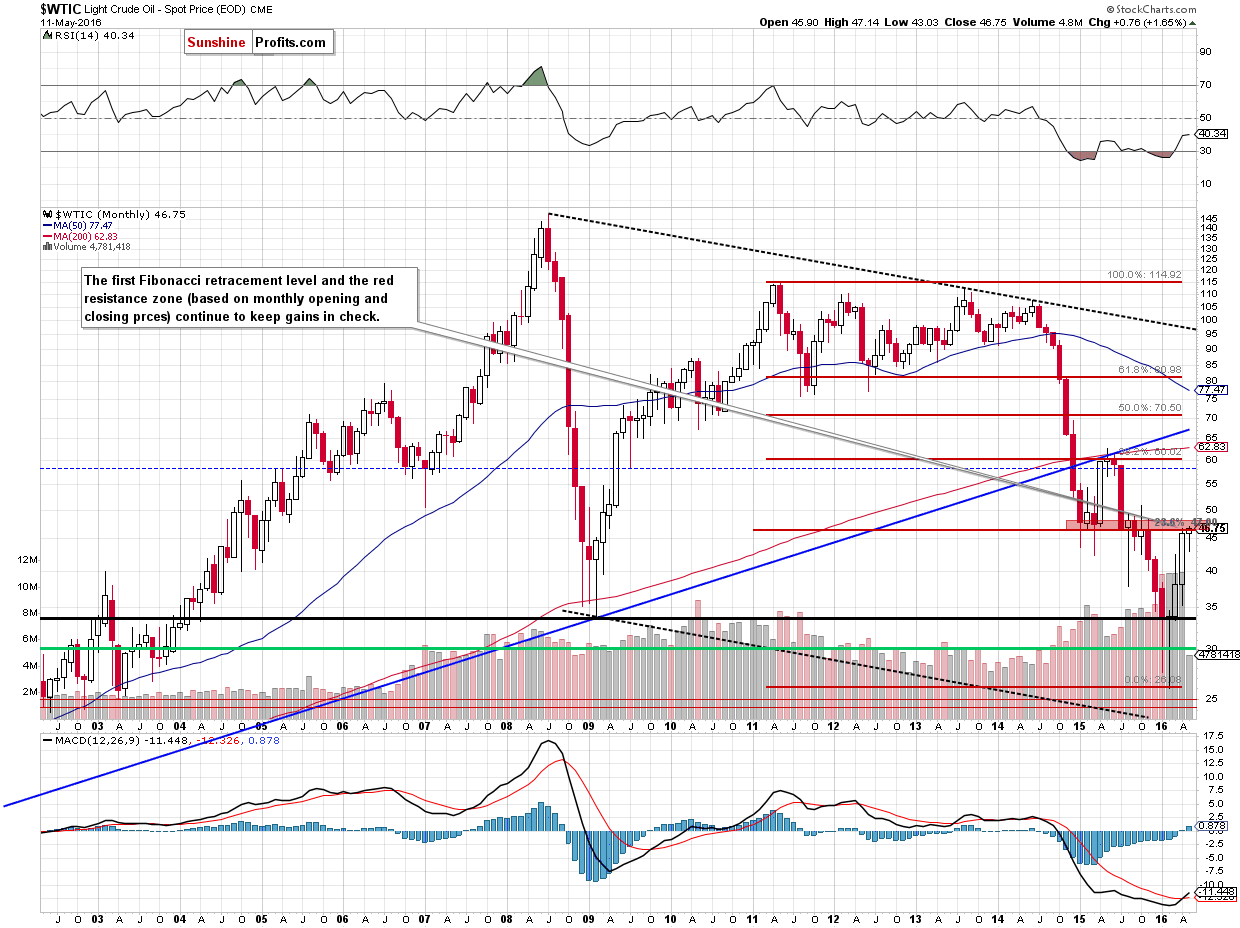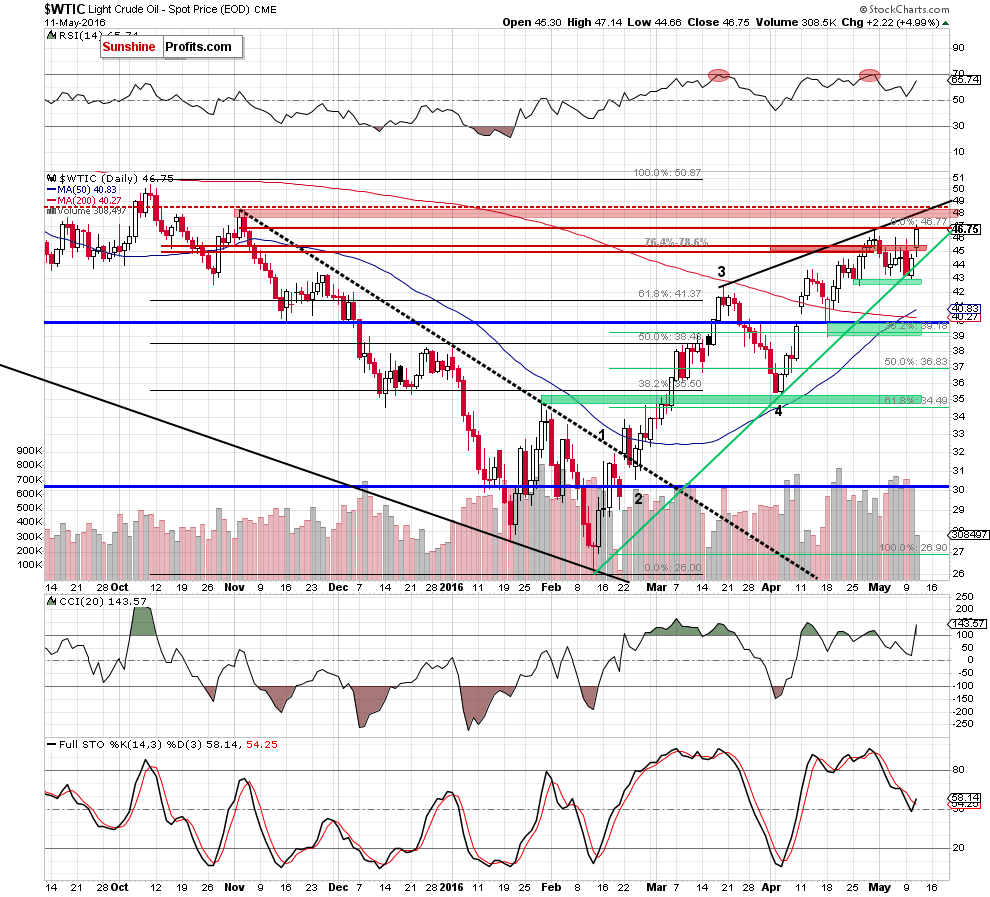Trading position (short-term; our opinion): Short positions (with a stop-loss order at $48.56 and initial downside target at $35.24) are justified from the risk/reward perspective.
On Wednesday, crude oil moved sharply higher after the EIA report showed larger-than-expected drop in crude oil, gasoline and distillates inventories. Thanks to these circumstances, light crude climbed above $46 once again, hitting a fresh 2016 high. Is this increase reliable? Or is it just overdone reaction to the surprising data?
Yesterday, the U.S. Energy Department's Energy Information Administration reported that U.S. crude oil inventories decreased by 3.4 million barrels for the week ending on May 6. The report also showed that gasoline inventories decreased by 1.2 million barrels and distillate inventories dropped by 1.6 million barrels. As a result, yesterday’s data showed a huge contrast between the estimate from the American Petroleum Institute and the government numbers, which pushed light crude slightly above the Apr high. But is this increase reliable? Let’s take a closer look at the charts below and try to answer this question (charts courtesy of http://stockcharts.com).


Based only on the above charts, we see that crude oil extended gains and climbed slightly above the Apr peak, hitting a fresh 2016 high of $47.14. Despite this move, light crude gave up some gains in the following hours, which resulted in a drop under the previous high. In this way, the commodity invalidated earlier small breakout, which is a negative signal.
Looking at the daily chart, we also see that the size of volume (which seems too low to us and we do not rule out that yesterday's numbers will be corrected in the coming days) was tiny, which raises doubts about the reliability of yesterday's increase. Additionally, the red resistance zone marked on the long-term chat continues to keep gains in check.
On top of that, there is one more important fact that we would like to comment. Although the commodity climbed to a fresh high (based on the above charts), we didn’t notice fresh highs in the case of crude oil’s futures. What’s interesting they remain under $47 also today (at the moment of writing these words), which suggests that yesterday's strong growth could only be exaggerated reaction to positive data and we’ll see lower prices when emotions will fall in the coming day(s).
Summing up, although crude oil climbed to a fresh high, the commodity declined, invalidating earlier small breakout above the Apr peak. Additionally, the commodity remains under the red resistance zone marked on the long-term chart and crude oil’s futures didn’t hit a fresh high yesterday, which in combination with the uncertainty associated with yesterday's numbers (the size of volume seems to us too small for such an increase) prompts us to maintain short positions.
Very short-term outlook: bearish
Short-term outlook: bearish
MT outlook: bearish
LT outlook: mixed with bearish bias
Trading position (short-term; our opinion): Short positions (with a stop-loss order at $48.56 and initial downside target at $35.24) are justified from the risk/reward perspective. We will keep you informed should anything change, or should we see a confirmation/invalidation of the above.
As a reminder – “initial target price” means exactly that – an “initial” one, it’s not a price level at which we suggest closing positions. If this becomes the case (like it did in the previous trade) we will refer to these levels as levels of exit orders (exactly as we’ve done previously). Stop-loss levels, however, are naturally not “initial”, but something that, in our opinion, might be entered as an order.
Since it is impossible to synchronize target prices and stop-loss levels for all the ETFs and ETNs with the main market that we provide this level for (crude oil), the stop-loss level and target price for popular ETN and ETF (among other: USO, DWTI, UWTI) are provided as supplementary, and not as “final”. This means that if a stop-loss or a target level is reached for any of the “additional instruments” (DWTI for instance), but not for the “main instrument” (crude oil in this case), we will view positions in both crude oil and DWTI as still open and the stop-loss for DWTI would have to be moved lower. On the other hand, if crude oil moves to a stop-loss level but DWTI doesn’t, then we will view both positions (in crude oil and DWTI) as closed. In other words, since it’s not possible to be 100% certain that each related instrument moves to a given level when the underlying instrument does, we can’t provide levels that would be binding. The levels that we do provide are our best estimate of the levels that will correspond to the levels in the underlying assets, but it will be the underlying assets that one will need to focus on regarding the sings pointing to closing a given position or keeping it open. We might adjust the levels in the “additional instruments” without adjusting the levels in the “main instruments”, which will simply mean that we have improved our estimation of these levels, not that we changed our outlook on the markets.
Thank you.
Nadia Simmons
Forex & Oil Trading Strategist
Przemyslaw Radomski, CFA
Founder, Editor-in-chief
Gold & Silver Trading Alerts
Forex Trading Alerts
Oil Investment Updates
Oil Trading Alerts



